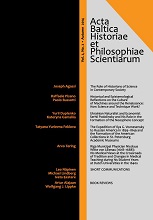Riga Municipal Physician Nicolaus Witte von Lilienau (1618–1688): His Medical Views at the Crossroads of Tradition and Changes in Medical Teaching during his Student Years at Dutch Universities in the 1640s
Riga Municipal Physician Nicolaus Witte von Lilienau (1618–1688): His Medical Views at the Crossroads of Tradition and Changes in Medical Teaching during his Student Years at Dutch Universities in the 1640s
Author(s): Arvo TeringSubject(s): History of Education, Health and medicine and law, 17th Century
Published by: Tallinna Tehnikaülikooli õiguse instituut
Keywords: Disputations in the 17th century; Harvey’s theory of blood circulation; history of medicine in the early modern period; Paracelsus’s concepts of medicine; philosophy of Descartes; reception of medical
Summary/Abstract: The main subject of this article, Nicolaus Witte von Lilienau (1618–1688), a native of Riga was the city’s municipal physician in 1652–1688. His studies at university proceeded during the 1640s in Netherlands, particularly at Leiden but also at Utrecht and Franeker. The universities of Leiden and Utrecht, in particular, developed at that time into strongholds for the supporters of Harvey’s theory of blood circulation and the philosophy of Descartes, from where those supporters spread the ideas that gradually found acceptance elsewhere as well. Witte was fortunate to have a closeup view of the fierce opposition between supporters and opponents of the philosophy of Descartes. Witte defended three disputations, two of which exercitii causa. The first was at Leiden on abdominal dropsy in 1645, the second was at Franeker on arthritis in 1647. He defended his doctoral dissertation on the plague at Leiden in 1648. Witte’s views on physiology were pioneering in all of his disputations. Under the apparent influence of his teacher Johannes Walaeus, Witte considered the teaching of blood circulation to be self-evident. Blood circulation was not the specific object of his research but used in interpreting the internal causes of illnesses. Witte’s choice of sides was his dedication of his disputation of 1645 to Descartes and his closest friends and public supporters. This was a very bold move, considering the conditions of those times. Yet this probably did not derive so much from Witte’s passion for Cartesian philosophy but rather from the fact that all those individuals were at the same time also supporters of the theory of blood circulation. Witte had negative attitude towards authorities considered to be infallible, whether they be authors from antiquity or more recent authors. Thus he distanced himself from the supporters of both Galen and Paracelsus, considering them rival sects. Witte distanced himself in his disputations from both Galen’s teaching of four bodily fluids, which was still widely accepted at that time, and the teaching of the movement of blood and of the liver as the centre for producing blood. Witte also denied the concepts of iatroastrology, iatromagic and iatrotheology associated primarily with the teachings of Paracelsus. Yet he did espouse the principle of three elements. And the learning of chemiatry.
Journal: Acta Baltica Historiae et Philosophiae Scientiarum
- Issue Year: 2/2014
- Issue No: 2
- Page Range: 70-116
- Page Count: 47
- Language: English

